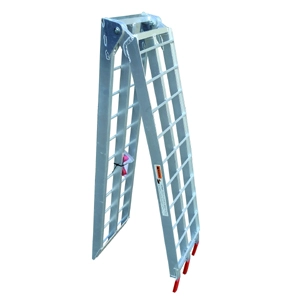Factors Influencing the Ideal Motorcycle Ramp Angle
Bike Weight and Power
The weight of your motorcycle plays a crucial role in determining the appropriate ramp angle. Heavier bikes require a gentler incline to prevent strain on both the rider and the vehicle during loading. Sport bikes, with their higher power-to-weight ratio, can generally handle steeper angles compared to cruisers or touring motorcycles. Consider your bike's specifications when selecting a motorcycle loading ramp to ensure a safe and smooth transition.
Rider Experience and Physical Capability
Your personal skill level and physical strength are important factors to consider. Novice riders or those with limited upper body strength may find it challenging to control a motorcycle on a steep ramp. In such cases, opting for a shallower angle provides more stability and control during the loading process. Experienced riders might be comfortable with steeper angles, but it's always wise to err on the side of caution.
Loading Surface and Environment
The surface you're loading onto, whether it's a truck bed, trailer, or elevated platform, influences the ideal ramp angle. A higher loading surface necessitates a longer ramp to maintain a manageable angle. Additionally, consider the environment where you'll be using the ramp. Uneven terrain or limited space may dictate the need for adjustable or folding ramps that can adapt to various situations while maintaining a safe angle.
Calculating the Optimal Motorcycle Ramp Length
The Mathematics Behind Ramp Length
To calculate the optimal length for your motorcycle ramp, you'll need to know the height of your loading surface and the desired angle. Use this formula: Ramp Length = Height / Sine of the Angle. For example, if your truck bed is 30 inches high and you want a 12-degree angle, the calculation would be: 30 / sin(12°) ≈ 144 inches or 12 feet. This ensures your moto ramp provides a safe and comfortable incline for loading.
Adjusting for Different Motorcycle Types
Different motorcycle styles may require slight adjustments to the ramp angle. Sport bikes with their higher ground clearance can typically handle steeper angles, while cruisers and touring bikes with lower clearances and longer wheelbases benefit from shallower angles. Always consider your specific motorcycle's characteristics when determining the ideal ramp length and angle.
Safety Margins and Practical Considerations
When in doubt, it's always better to opt for a longer ramp that provides a shallower angle. This gives you a safety margin and makes the loading process less stressful. Remember that while a longer ramp takes up more space, it significantly reduces the risk of accidents or damage to your motorcycle during loading and unloading. Invest in a quality motorcycle loading ramp that offers the right balance of length, strength, and portability for your needs.
Best Practices for Using Motorcycle Ramps Safely
Proper Ramp Setup and Securement
Before using your motorcycle ramp, ensure it's properly set up and secured. Most quality ramps come with safety straps or hooks to attach them firmly to your loading surface. This prevents the ramp from slipping or shifting during use. Always check that the ramp is centered and aligned with your vehicle or trailer. A stable foundation is crucial for a safe loading process, regardless of the ramp angle.
Technique for Riding Up and Down the Ramp
When using a motorcycle ramp, maintain a steady, controlled speed. Too slow, and you risk losing momentum; too fast, and you could lose control. Keep your body centered on the bike and look ahead, not down at the ramp. For steeper angles, some riders prefer to walk alongside their bike, using the throttle to assist the ascent. When descending, use your brakes judiciously to maintain a safe speed. Practice these techniques in a safe environment to build confidence.
Regular Maintenance and Inspection of Ramps
To ensure ongoing safety, regularly inspect your motorcycle loading ramp for signs of wear or damage. Check for any bends, cracks, or loose components. Keep the ramp clean and free from oil or debris that could cause slippage. If your ramp has moving parts, such as hinges or folding mechanisms, lubricate them as needed. Proper maintenance not only extends the life of your ramp but also ensures it remains safe and reliable for years to come.
Conclusion
Choosing the right angle for your motorcycle ramp is crucial for safe and efficient loading. While the ideal angle typically falls between 11 to 15 degrees, factors such as your bike's specifications, your experience level, and the loading environment all play a role in determining the best angle for your needs. Remember, a shallower angle offers more safety and ease of use, especially for heavier bikes or less experienced riders. By carefully considering these factors and following best practices for ramp usage and maintenance, you can ensure a smooth and secure loading experience every time you transport your motorcycle.
Contact Us
Ready to find the perfect motorcycle ramp for your needs? Contact us at info@runva.com.cn for expert advice and high-quality motorcycle loading solutions tailored to your specific requirements.

_1737625693698.webp)


